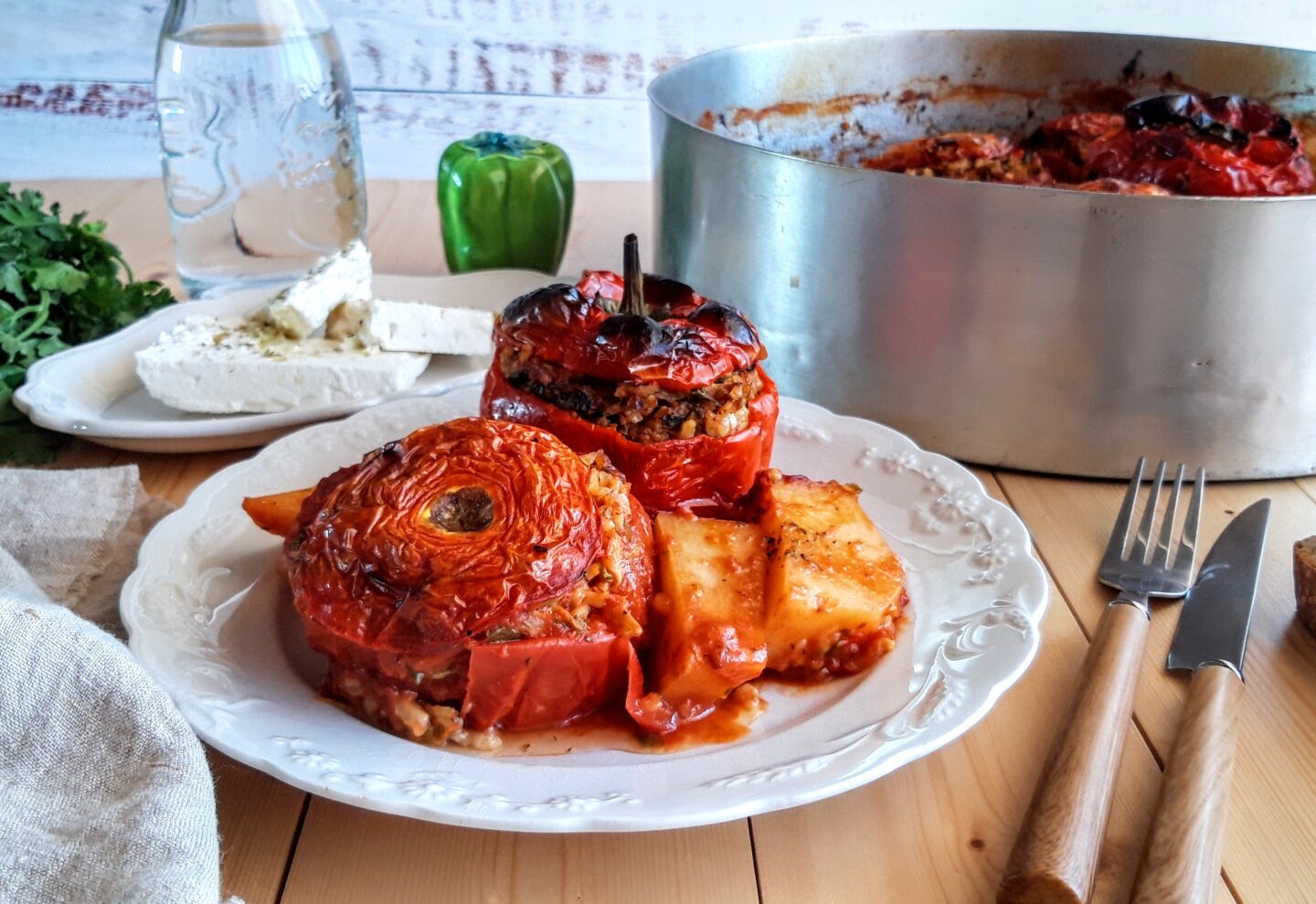When it comes to Greek cuisine, few dishes encapsulate the essence of a Mediterranean summer better than Gemista. This delightful concoction of stuffed vegetables is a cherished favorite, handed down through the generations, and its flavor never wanes with time. Picture this: you return from a scorching day at the beach, craving something refreshing to complement your cold beer.
That’s when a plate of Gemista graces your table, seemingly simple but with a preparation process that carries the secrets of every home chef. Today, I’m sharing some of my own secrets for making the perfect Greek Gemista.
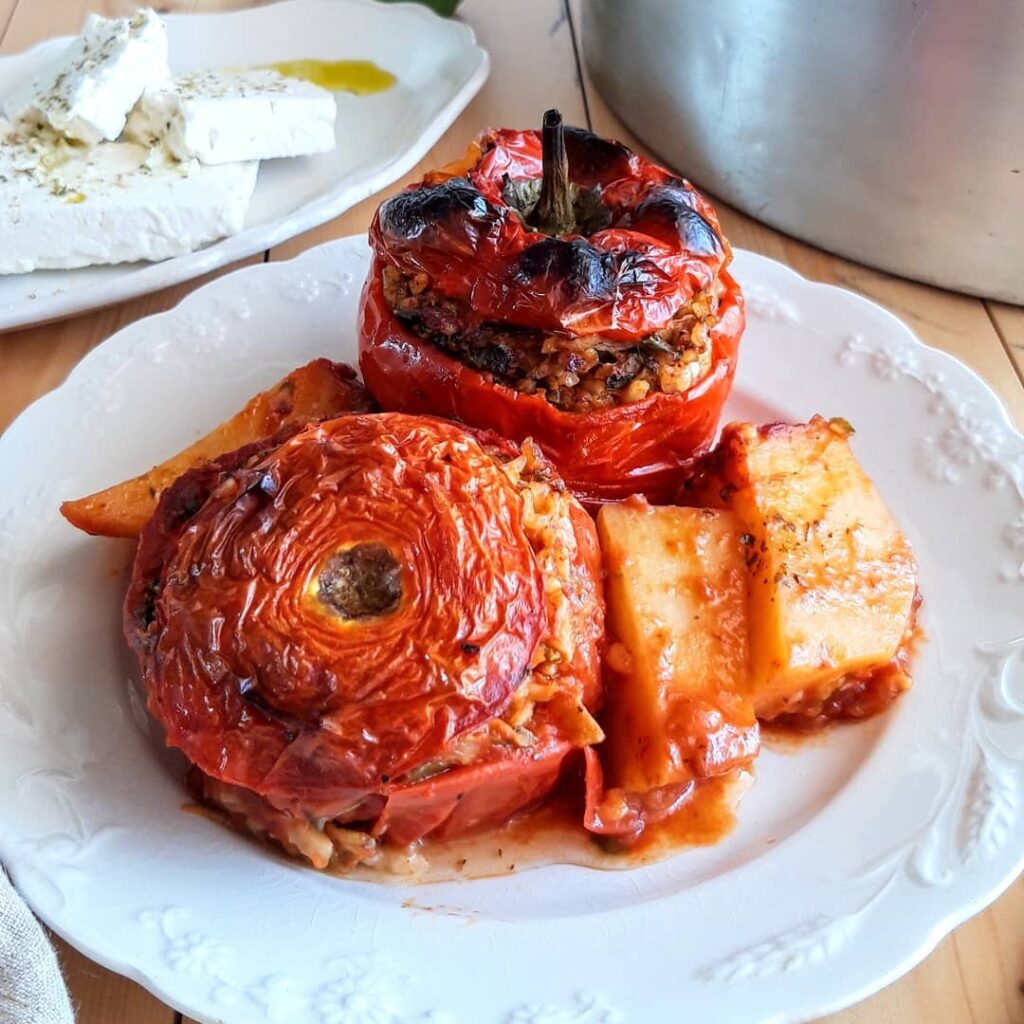
Contents
Origin and History of Gemista
Greek Gemista, also known as Yemista, pronounced: ye-meesta, is a beloved traditional dish with deep roots in Greek culture. The term “Gemista” is derived from the Greek word “gemizo,” which means “to fill” or “to stuff.” This dish reflects the Mediterranean love for fresh, seasonal produce. The practice of stuffing vegetables goes back centuries, as it was a practical way to utilize available ingredients. Over time, various regions in Greece have added their own unique twists to the recipe, resulting in diverse variations of Greek Gemista that also contain minced beef or pork.
Ingredients for Greek Gemista Recipe (Stuffed Vegetables with Rice)
To make the best Gemista you’ll need the following ingredients, to get a better understanding of the role each component plays in creating the wonderful flavors of Greek Gemista. Enjoy the process of cooking this delicious dish and savor the rich Mediterranean taste it delivers.
- Ripe Tomatoes (4 pieces): Choose ripe, firm tomatoes for the base of your Gemista. They provide a sweet, juicy foundation for the stuffing, and their vibrant red color adds a beautiful touch to the dish. The tomatoes are hollowed out and filled with a delectable rice mixture, which soaks up their succulent juices during baking.
- Red and Yellow Peppers (2 pieces each): The vibrant colors of red and yellow peppers not only make your Gemista visually appealing but also infuse the dish with a sweet, slightly tangy flavor. These peppers are cored and stuffed, providing a delicious contrast to the rice filling.
- Large Courgettes (2 pieces): Courgettes, also known as zucchinis, add a mild, earthy taste and a delightful texture to your Gemista. Grating them and allowing them to drain helps eliminate excess moisture, ensuring the final dish is perfectly balanced and not too watery.
- Florina Peppers (2 pieces): Florina peppers, hailing from Greece, are a unique ingredient that brings a distinctive flavor to your Gemista. Grated and added to the stuffing, they offer a subtle sweetness and a touch of smokiness to the dish.
- Large Potatoes (2 pieces): The potatoes play a supporting role in your Gemista, adding a heartiness to the dish. Cut into cubes and placed around the stuffed vegetables, they absorb the flavorful pan sauce and become tender, making them a tasty accompaniment.
- Onions (2 pieces): Onions are an essential part of the stuffing mixture. Grated and sautéed to a translucent state, they release a sweet aroma and mellow flavor that underlines the Mediterranean character of the dish.
- Garlic (2 finely chopped cloves): The finely chopped garlic cloves bring a subtle pungency and depth to the stuffing. When sautéed with the onions, they infuse the dish with a wonderful aroma.
- Rice (80g nihaki rice and 80g carolina rice): A combination of nihaki and carolina rice offers a fantastic texture and absorbs the flavors of the herbs and spices in the stuffing. It binds the ingredients together, creating a delightful, well-seasoned filling.
- Fresh Herbs (1/2 cup finely chopped parsley, 1/2 cup finely chopped mint): Fresh parsley and mint brighten up your Gemista with their aromatic, herbaceous notes. These herbs bring a burst of freshness to the dish, enhancing the overall experience.
- Olive Oil (110g): Olive oil is the heart and soul of Mediterranean cooking. It’s not only used to sauté the onions and zucchini but also added to the pan sauce, creating a luscious, golden coating that envelops the stuffed vegetables.
- Sweet Paprika Powder (1 tsp) and Sweet Chili Powder (1 tbsp): These spices infuse your Gemista with a hint of warmth and a gentle kick of heat. The sweet paprika and chili powder contribute a mild, smoky spiciness that’s balanced by the sweetness of the other ingredients.
- Dried Oregano (1 tsp) and Dried Thyme (1 tsp): The combination of dried oregano and thyme adds a Mediterranean charm to your dish. These dried herbs provide an earthy, savory character, enhancing the stuffing’s flavor profile.
- Granulated Sugar (1 tsp): A touch of granulated sugar adds a subtle sweetness to your Gemista, harmonizing the flavors and helping to create a balanced taste.
- Salt and Pepper: These pantry staples are crucial for seasoning your Gemista to perfection. Salt enhances the flavors of the ingredients, while pepper adds a gentle touch of spiciness.
For the Pan Sauce:
- Ripe Tomatoes (3 pieces, seedless, grated): These grated, seedless tomatoes form the base of the pan sauce. They provide a rich, tomatoey essence that infuses the stuffed vegetables with a tangy, juicy goodness.
- Florina Pepper (1 piece, seedless, grated): Grated seedless Florina pepper brings a unique, slightly smoky flavor to the pan sauce, enhancing the overall Mediterranean appeal.
- Olive Oil (100ml): Olive oil used in the pan sauce coats the Gemista with a golden sheen, offering a delightful richness and depth of flavor.
- Salt and Pepper: Seasoning is essential in the pan sauce as well, ensuring it’s perfectly balanced and flavorful.
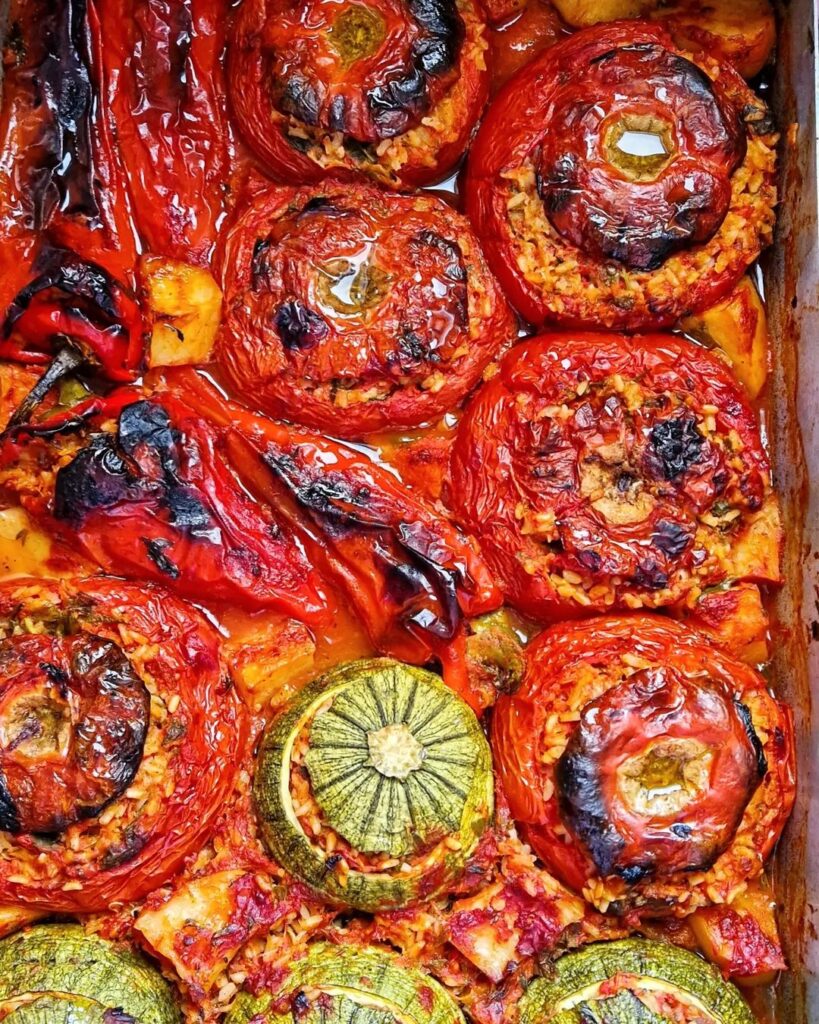
How to Cook Greek Gemista (Stuffed Vegetables with Rice)
Preparation:
- Prepping the Vegetables: Start by preparing the vegetables. Carefully cut the tops off the tomatoes and use a spoon to scoop out the flesh, which will be used in the filling later. For the peppers, cut off the tops and remove the seeds, preserving the caps. For the courgettes, grate them using a coarse grater and leave them in a pasta strainer to drain for about 30 minutes to remove excess moisture.
- Filling Mixture: In a deep mixing bowl, combine the grated Florina peppers with the grated tomato flesh, nihaki rice, carolina rice, finely chopped parsley, mint, sweet paprika, sweet chili powder, dried oregano, dried thyme, and granulated sugar. Season with a pinch of salt and pepper. Mix everything thoroughly to create a flavorful stuffing.
- Sautéing the Onion: Grate the onions and place a deep frying pan on the stove. Heat the olive oil over medium heat, and after about two minutes, add the grated onion. Sauté it gently until it becomes translucent, making sure not to brown it or it may impart bitterness to the dish. Add the finely chopped garlic and continue sautéing for a couple more minutes.
- Adding the Zucchini: Now, it’s time to incorporate the grated courgettes. Add them to the pan with the sautéed onions and garlic, and stir well. Allow the courgettes to release their liquid over medium-high heat, and after approximately 10 minutes, remove the pan from the heat. Transfer this mixture to the bowl containing the other stuffing ingredients. Season with salt and pepper and gently mix everything together.
- Preheating the Oven: Preheat your oven to 200°C (392°F) to get it ready for baking.
Assembling and Baking:
- Filling the Vegetables: Using a spoon, generously fill the hollowed-out vegetables with the prepared rice mixture, ensuring they’re packed but not overly tight. Place the caps back on top of the peppers and tomatoes.
- Arranging the Tray: Set your stuffed vegetables in a medium-sized baking tray, arranging them with the caps facing up. Add the cubed potatoes in between the vegetables for an extra burst of flavor.
- Pan Sauce: In a mixing bowl, combine the grated seedless tomatoes, grated seedless Florina pepper, olive oil, and a pinch of salt and pepper. Pour this sauce over the vegetables, allowing it to infuse them with a rich, tangy taste.
- Baking Gemista: Place the baking tray in the preheated oven and bake for approximately 1 to 1.5 hours. The cooking time may vary depending on your oven, so keep an eye on the dish to ensure it doesn’t overcook. You’ll know it’s ready when the vegetables are tender, and the stuffing is cooked to perfection.
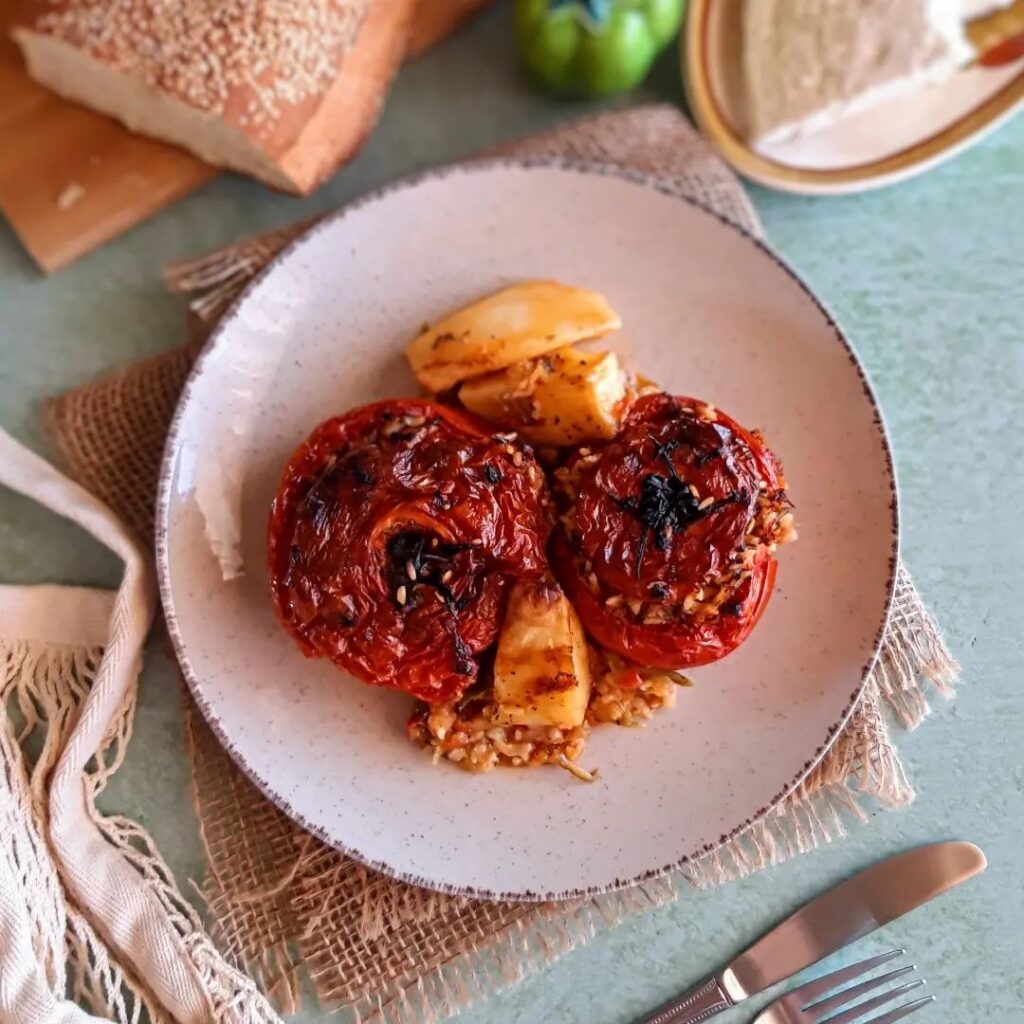
Serving:
Enjoy your Greek Gemista best at room temperature or cold, alongside feta cheese and fresh bread. This classic dish offers a tantalizing taste of Greek summer that you’ll want to savor again and again.
In conclusion, cooking Greek Gemista is not just a culinary experience; it’s a tradition that brings people together, celebrating the flavors of Greece. This dish encapsulates the essence of Mediterranean life – simple, fresh, and utterly delicious. So, gather your family and friends, and create lasting memories while relishing this timeless Greek delight.
Enjoy your homemade Greek Gemista!
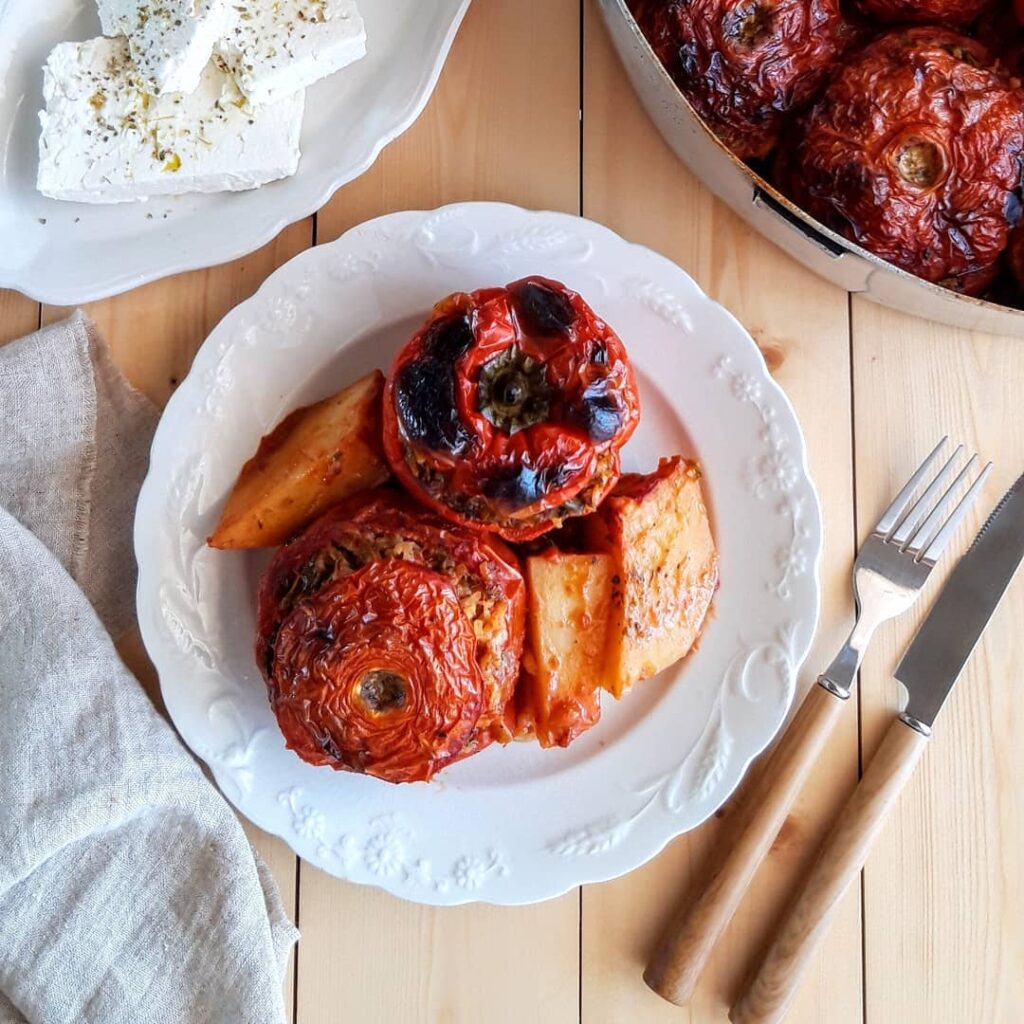
Keep on reading to find the the full printable Greek Gemista Recipe (Stuffed Vegetables)
Greek Gemista Recipe (Stuffed Vegetables with Rice)
Ingredients
- 4 piece ripe tomatoes
- 2 piece red peppers
- 2 piece yellow peppers
- 2 piece zucchini large
- 2 piece Florina peppers
- 2 piece potatoes large, cut into cubes
- 2 piece onions large
- 2 piece garlic teeth finely chopped
- 80 grams Nihaki rice
- 80 grams Carolina rice
- 1/2 piece finely chopped parsley
- 1/2 piece mint finely chopped
- 110 grams olive oil
- 1 tablespoon sweet paprika powder
- 1 tablespoon sweet chilli
- 1 teaspoon dried oregano
- 1 teaspoon dried thyme
- 1 teaspoon granulated sugar
- salt
- Pepper
For the pan:
- 3 piece ripe tomatoes without seeds, grated on a coarse grater
- 1 piece Florina pepper, grated on a coarse grater
- 100 ml olive oil
- salt
- Pepper
Instructions
- Grate the courgettes on the coarse grater of the onion and leave them to drain for 30 minutes in the pasta strainer to release the liquid.
- Grate the Florina peppers on the coarse onion grater and place them in a deep bowl.
- Cut the tops off the tomatoes on the stem side and use a spoon to remove the flesh and grate it on the onion grater and add it to the bowl with the Florina peppers. Into the bowl add the rice along with the chopped herbs and the sweet paprika, sweet chilli, dry oregano , dry thyme and sugar.
- Cut the caps off the peppers on the stem side remove the seeds from the caps and set aside.
- Grate the onion on a coarse grater and place a deep frying pan on the fire to heat up and add the olive oil and after two minutes add the onion to sauté lightly along with the garlic, being careful not to burn them as they will make the food bitter.
- Leave it for two or three minutes and add the pumpkin well smashed and stir with a large spoon.
- Allow the zucchini to release its liquid over medium-high heat and after 10 minutes, remove the pan from the heat and add the mixture to the bowl with the other ingredients. Finally, add salt and pepper and mix gently.
- Preheat the oven to 200°C (392°F).
- Start filling the sprouts with a spoon up to the top and cover with lids.
- Place them in order on a medium baking tray with the lids up.
- Cut the potatoes into cubes and place them in between the vegetables.
- Mix the ingredients for the pan sauce in a bowl and pour it over the vegetables.
- Bake for 1 to 1.5 hours, depending on your oven's settings.
- Serve preferably when they come to room temperature or cold with feta cheese and fresh bread.
Greek Gemista Frequently Asked Questions
What is Greek Gemista ?
Greek Gemista, also known as Yemista, is a traditional and popular Greek dish that consists of stuffed vegetables, typically tomatoes, courgettes (zucchini), eggplants and bell peppers, filled with a flavorful mixture of rice, herbs, and sometimes ground meat. The word “Gemista” is derived from the Greek word “gemizo,” which means “to fill” or “to stuff.”
The inside of the vegetables is hollowed out, creating a cavity that is then filled with a mixture of rice, fresh herbs such as parsley and mint, and various spices. The stuffing is often vegetarian, but some variations of Gemista may include ground meat, such as beef or pork.
The stuffed vegetables are then baked in the oven until the rice is cooked and the vegetables become tender. The baking process allows the flavors of the stuffing to meld with the natural juices of the vegetables, creating a rich and savory dish.
The dish is a beloved part of Greek cuisine, and variations of Gemista can be found in different regions of Greece, each with its unique twist on the recipe. It’s a delicious and comforting dish that reflects the Mediterranean love for fresh, seasonal ingredients and traditional cooking methods.
Are Gemista Healthy ?
Greek Gemista can be a healthy and nutritious dish, particularly when prepared with a focus on wholesome ingredients and a balanced approach. Here are some key considerations regarding the healthiness of Gemista:
1. Nutrient-Rich Vegetables: Gemista is primarily made from fresh, ripe vegetables, including tomatoes, bell peppers, and zucchinis. These vegetables are excellent sources of essential nutrients, including vitamins, minerals, and dietary fiber. They provide vitamins such as vitamin C and vitamin A, as well as dietary fiber, which can promote digestive health.
2. Balanced Ingredients: When the stuffing for Gemista is prepared with a balanced combination of ingredients, it can be a nutritious choice. Using a variety of fresh herbs, such as parsley and mint, not only adds flavor but also provides additional nutrients and antioxidants. Choosing whole grains like rice, as well as incorporating olive oil, adds healthy fats and complex carbohydrates to the dish.
3. Vegetarian Option: Gemista can be made in a vegetarian or vegan version by excluding meat from the stuffing. This makes it a great plant-based meal option, providing ample fiber and plant-based proteins from the vegetables and rice.
4. Minimal Processing: Gemista typically involves minimal processing, and the vegetables are usually baked rather than fried, helping to retain their nutritional value.
5. Portion Control: As with any dish, portion control is essential for maintaining a balanced diet. Gemista can be filling, so it’s important to be mindful of portion sizes to avoid overeating.
6. Versatility: Gemista is a versatile dish, and you can adjust the ingredients and stuffing to suit your dietary preferences and nutritional goals. For instance, you can choose brown rice for added fiber or reduce the amount of oil for a lower-fat version.
However, it’s important to be aware of a few factors that may affect the healthiness of Gemista:
1. Calories and Portion Size: Gemista can be calorie-dense, especially if it’s prepared with a generous amount of rice and olive oil. Be mindful of portion sizes to control calorie intake.
2. Salt and Seasonings: Depending on the recipe, Gemista may contain added salt and seasonings. Excessive salt intake can have health implications, so it’s important to manage the sodium content.
3. Meat and High-Fat Versions: If you choose to include ground meat in your Gemista or use excessive amounts of oil, it can increase the dish’s calorie and fat content. Moderation is key in such cases.
4. Dietary Preferences: Gemista may not align with certain dietary preferences or restrictions, such as low-carb or gluten-free diets.
In summary, Greek Gemista can be a healthy and nutritious option when prepared with an emphasis on fresh, whole ingredients and a balanced approach. It’s a dish that can be adapted to various dietary needs, offering a wealth of nutrients from the vegetables and the potential for a satisfying, well-rounded meal.
To make Gemista even healthier, consider using whole grains, lean protein sources, and minimal added salt and fats.
DID YOU MAKE THIS RECIPE?
Be sure to leave a star rating and comment below!
Tell me how was it! Leave me your comment below and tag your photos @greekdishrecipes on Instagram and hashtag it #greekdishrecipes

